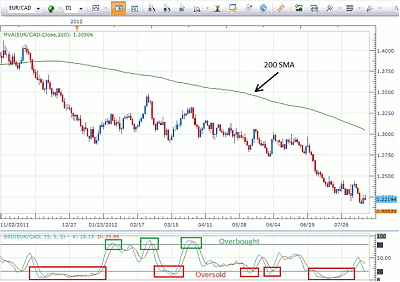Richard Krivo of DailyFX.com explains a simple method for determining where currency pair lies in the spectrum.
Have you ever heard an analyst state something like “the AUD/USD is overbought and due for a correction” or that “the EUR/NZD is oversold and due for a bounce”? This may sound like pretty compelling information, but what exactly does it mean?
These terms are used to describe a market condition that is quantified by certain technical indicators. These indicators are called oscillators, with two popular examples being Stochastics and RSI. An oscillator is a commonly used momentum indicator that measures the current price of a currency pair compared to its historical price over a given time period.
The scale for both of the indicators is 0 to 100. When Stochastics reaches the level of 80, the market is considered overbought, and when Stochastics reaches the level of 20, the market is considered oversold. RSI uses the same scale of 0 to 100, but the value for overbought is 70, while the value for oversold is 30. The idea is when the market reaches either extreme, the chance for a reversal increases.
However, this does not mean that a reversal is imminent. Markets that are in a strong uptrend can remain overbought for long periods of time, and markets that are in a strong downtrend can remain oversold for long periods of time. This is why these oscillators have a somewhat limited value in trending markets.
However, when the market is in a downtrend and the oscillator moves up to overbought, there is a much better chance of a reversal. Conversely, when the market is in an uptrend and the oscillator moves down to oversold, there is also a better chance of a reversal.
Here is an example using the daily chart of the EUR/CAD. Also plotted on the chart is Slow Stochastics using values of 15,5,5.
You can see that when the market is in a downtrend (lower highs and lower lows and price trading below the 200-period simple moving average (SMA), Stochastics will spend more time in an oversold condition and less time in the overbought condition. This is typical in a strongly downtrending market.
Also, when Stochastics moves up to an overbought condition, the market has a tendency to reverse and move back in the direction of the trend. This is one way that traders use this tool to identify a trading opportunity. The key here is that the market is in a downtrend and, as such, we would look for selling signals from Slow Stochastics. That signal would be the indicator moving down from above 80.
If the market was in an uptrend, the opposite would be true, and we would treat a move down to oversold as a buying opportunity when Stochastics moved back above 20.
So while oscillators can be valuable in identifying trading opportunities, it is the direction of the trend and trading in that same direction that increases the reliability of these tools.
Richard Krivo is a trading instructor at DailyFX.com.






















